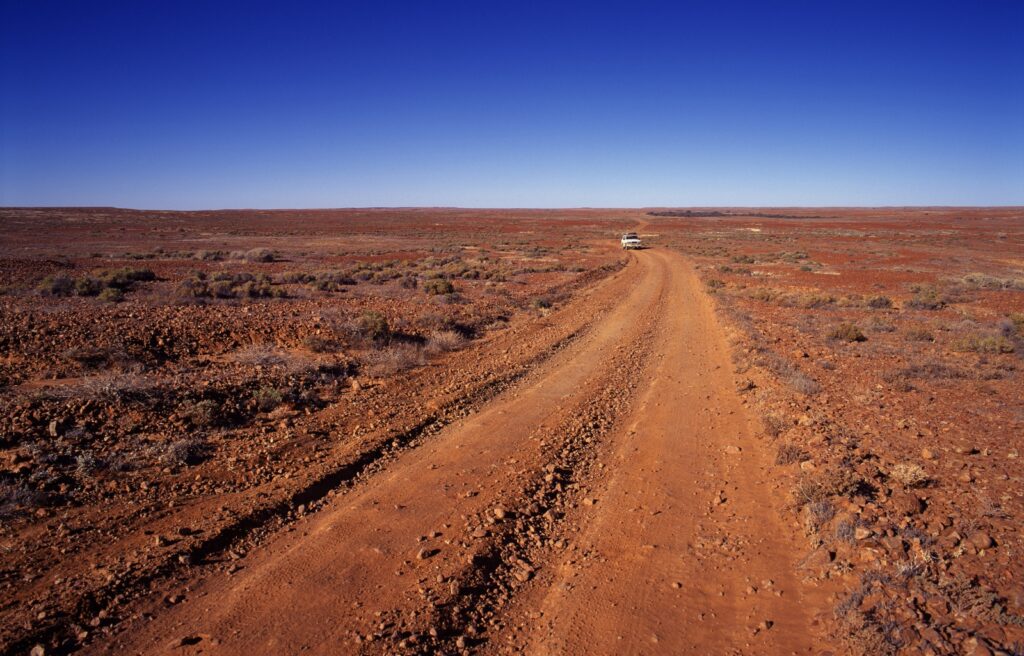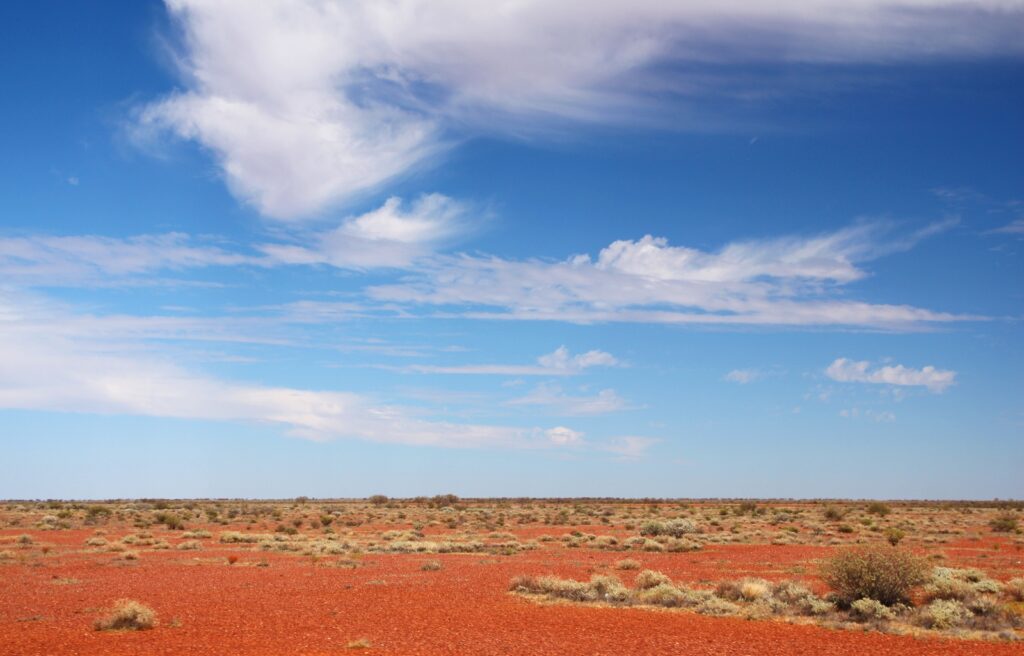Planning a journey through the Aussie Outback can feel like a bit of a daunting task, right? No worries, mate—we’ve been down that track, scouring for the top routes and handy tips.
Did you know the Outback sprawls over 2.5 million square miles of rugged desert and bushland? You’re in good hands; our guide’s got everything you need to nail your trip, from picking the proper 4WD to making sure your swag’s packed with all the essentials.
Time to hit the road and soak up some unforgettable adventures!
Key Takeaway
- Planning your trip during the cooler months from May to September is best for comfortable weather and safer travels in the Outback.
- Choosing the right vehicle, such as a 4WD or SUV, is crucial for handling the rough terrain and long distances of Australia’s rugged wilderness.
- Pack essential items like a first-aid kit, navigation tools, and camping equipment to ensure safety and comfort while exploring remote areas.
- Exploring top Outback routes like the Nullarbor, Gibb River Road, and Red Centre Way offers unique adventures across diverse landscapes.
- Always carry extra supplies such as water, food, and fuel, and be mindful of your environmental impact while enjoying the vast beauty of the Australian Outback.

Best Time to Visit the Outback
Choosing the best time to visit the Outback is crucial for enjoying your Australian adventure. The most ideal period is during the cooler months from May to September. During these months, daytime temperatures are pleasant and nights get a bit chilly, perfect for camping under the stars.
This season also sees less rain, making road trips safer and more enjoyable.
With clearer skies and milder weather, exploring remote areas becomes easier. You can enjoy bushwalking without the scorching sun or heavy rains disrupting your plans. Wildlife encounters are more likely as animals venture out in comfortable temperatures.
After deciding on the best time to go, you’ll need to think about what vehicle will suit your journey into Australia’s wilderness.
Choosing the Right Vehicle for Your Outback Adventure
When embarking on an Outback adventure, selecting the right vehicle is crucial. Consider factors such as terrain, distance to be covered, and the number of passengers when choosing a suitable vehicle for your journey.
Factors to Consider
When planning an Outback adventure, it’s important to consider a few key factors:
- Terrain: The rugged and often challenging terrain of the Outback requires a vehicle with good ground clearance and sturdy off-road capabilities.
- Weather: The Outback experiences extreme weather conditions, from scorching heat to sudden storms. Choose a vehicle that can handle these conditions and ensure you have appropriate gear for protection.
- Distance: The vast distances between fuel stops and amenities in the Outback mean you need a vehicle with excellent fuel efficiency or ample storage for extra fuel.
- Remote Travel: Consider the level of remote travel you plan to undertake, as this will impact your choice of vehicle and the supplies you need to carry.
Types of Vehicles Suitable for the Outback
Choosing the right vehicle for your Outback adventure is crucial. The vast and diverse terrains of Australia’s Outback demand reliable and sturdy vehicles. Let’s look at the types of vehicles that are best suited for this unique journey.
| Type of Vehicle | Description | Benefits |
|---|---|---|
| 4WD (Four-Wheel Drive) | Rugged vehicles designed for off-road conditions. | Offers better traction and handling on rough tracks. |
| SUV (Sports Utility Vehicle) | Comfortable for both city and off-road driving. | Spacious and versatile, it is suitable for families. |
| All-Wheel Drive | Provides power to all wheels for improved grip. | Ideal for varied Outback terrains. |
| Camper Van | Equipped with basic living amenities. | Allows for accommodation on the go. |
| Off-Road Caravan | Sturdy and designed for the outback. | Perfect for longer stays in remote areas. |
Next up, we’ll talk about the essential items to bring on your outback trip to ensure a safe and enjoyable experience.
Essential Items to Bring on Your Outback Trip
Pack safety gear, such as a first aid kit and emergency communication devices. Bring navigation tools like GPS systems or maps to ensure you stay on course during your adventure.
Safety Gear
When exploring the Outback, it’s crucial to pack essential safety gear to ensure a smooth and secure journey. Here are the must-have safety items for your Outback adventure:
- First Aid Kit: Be prepared for any minor injuries or medical emergencies during your trip.
- Emergency Communication Device: Carry a satellite phone or emergency beacon to call for help in remote areas.
- Fire Extinguisher: In the event of a vehicle fire or bushfire, having a fire extinguisher can be life-saving.
- Personal Locator Beacon (PLB): A PLB can pinpoint your location and send distress signals in case of an emergency.
- Emergency Blankets: Stay warm and protected from harsh weather conditions with thermal blankets.
- Waterproof Matches: Ensure you have reliable means to start a fire for cooking or warmth.
- Flashlight and Extra Batteries: Essential for navigating in the dark or signalling for help.
- Snake Bite Kit: Protection against venomous snake bites is crucial in the Outback’s wilderness.
Navigation Tools
For your Outback adventure, bringing the right navigation tools is essential. Here are the must-have items to ensure a safe and enjoyable trip:
- GPS Navigation System: A reliable GPS unit is crucial for finding your way through the vast and remote Outback landscapes.
- Paper Maps: Although technology is useful, always carry detailed paper maps as a backup in case of GPS failure or signal loss.
- Compass: A traditional compass can be invaluable for orienteering and navigating when electronic devices are unavailable or unreliable.
- Satellite Phone: In areas with no mobile reception, a satellite phone provides a lifeline in case of emergencies.
- Road Atlas: A comprehensive road atlas will help you plan routes effectively and navigate off-the-beaten-path destinations with ease.
- Binoculars: Binoculars are handy for spotting landmarks, wildlife, and key locations from a distance during exploration.
- Travel Guidebooks: Look for guidebooks specific to the Outback regions you’re visiting, providing detailed insights into local attractions and points of interest.
Camping Equipment
After ensuring you have the right navigation tools to guide your journey through the Outback, it’s essential to pack the appropriate camping equipment for an unforgettable adventure. Here’s a list of must-have camping gear:
- Tent: A sturdy and weather-resistant tent is vital for shelter in the outback’s unpredictable conditions.
- Sleeping Bags: Opt for high-quality sleeping bags suitable for varying temperatures, keeping you warm during chilly nights.
- Cooking Gear: Portable stoves, cooking utensils, and lightweight cookware are necessary for preparing meals while on the road.
- Water Filtration System: Access to clean water may be limited, so a reliable water filtration system is indispensable.
- Lighting: LED lanterns, headlamps, and flashlights will provide illumination during nighttime activities or emergencies.
- First Aid Kit: Stock up on a comprehensive first aid kit to handle minor injuries and medical needs during your journey.
- Camp Chairs and Table: Comfortable seating and a table make outdoor dining and relaxation more enjoyable at campsites.
- Portable Power Source: Consider bringing a portable power bank or solar charger to keep electronic devices charged in remote areas.
- Multi-tool Knife: This versatile tool can serve various purposes, such as cutting, opening cans, or fixing equipment.
- Tarpaulin or Groundsheet: Protect your tent floor from rough terrain and moisture with a durable tarpaulin or groundsheet.
- Rubbish Bags: Keep the environment clean by packing rubbish bags to dispose of waste responsibly while on your journey through the outback.
- Insect Repellent: An essential item to ward off pesky insects that inhabit certain areas of the outback.
Top Outback Routes to Explore
Embark on a journey through the vast and diverse Outback, where you can traverse the iconic Nullarbor, tackle the rugged Gibb River Road, and witness the stunning landscapes along the Red Centre Way.
Read on to discover more thrilling routes that await your exploration in this ancient land.
The Nullarbor
The Nullarbor offers a vast expanse of arid landscapes to explore. You can encounter unique flora and fauna while driving through this remote region. The Eyre Highway crosses the Nullarbor, providing an opportunity to experience one of the world’s longest straight stretches of road.
It’s also home to the Nullarbor Links, an 18-hole golf course spanning 1,365 kilometres from Kalgoorlie in Western Australia to Ceduna in South Australia.
Travellers can take a break at roadhouses along the way for fuel, food, and accommodation. Be sure to stock up on supplies, as services are limited in this isolated area. Don’t miss the chance to visit the Head of Bight during the whale-watching season or marvel at awe-inspiring limestone caves such as Murrawijinie Caves and Cocklebiddy Cave.
The Gibb River Road
The Gibb River Road provides an exhilarating outback experience, with stunning gorges, crystal-clear waterholes, and rugged landscapes to explore. Travellers can navigate the challenging terrain in a 4×4 vehicle and appreciate the enchanting natural beauty of Windjana Gorge, Bell Gorge, and Manning Gorge.
Embrace the adventurous spirit as you hike through ancient land formations and delve into the refreshing waters of these picturesque locations. Immerse yourself in Aboriginal culture by visiting local communities along the way, gaining insight into their traditions and history.
Embarking on The Gibb River Road is an opportunity to witness some of Australia’s most spellbinding scenery while experiencing an unforgettable adventure that will leave lasting memories.
The Red Centre Way
Transitioning from the rugged terrain of the Gibb River Road, travellers can venture onto the iconic Red Centre Way. This 1130-kilometer route cuts through the heart of Australia, taking explorers on a journey to some of the country’s most renowned natural and cultural landmarks.
Along this route, visitors will encounter breathtaking sights such as Uluru-Kata Tjuta National Park, Kings Canyon, and Alice Springs. The drive offers an immersive experience of Aboriginal culture and history while revealing the stark beauty of Australia’s red desert landscapes.
The Savannah Way
The Savannah Way traverses the tropical savannahs of Australia, stretching over 3,700 kilometres from Cairns in Queensland to Broome in Western Australia. This iconic route is known for its diverse landscapes and rich cultural heritage, offering an unforgettable outback experience.
Along the way, travellers can explore ancient rock art sites at Kakadu National Park, witness stunning waterfalls at Litchfield National Park, and encounter unique wildlife such as kangaroos and crocodiles.
For those seeking a self-drive adventure through rugged terrain and remote communities, The Savannah Way promises an authentic Australian journey filled with exploration and discovery.
From lush rainforests to vast deserts, this route encapsulates the true essence of the Australian Outback.
Nature’s Way
Explore Nature’s Way, a scenic route that winds through the heartland of Australia. Admire stunning landscapes, ancient rock formations, and lush national parks along the way. Immerse yourself in the culture and heritage of the Aboriginal people at various cultural sites nestled within this breathtaking stretch.
Discover pristine waterfalls, verdant rainforests, and diverse wildlife as you journey through Kakadu National Park, Litchfield National Park, and Nitmiluk National Park. Marvel at majestic gorges and serene waterways while experiencing the untouched beauty of the Australian Outback.
Explorer’s Way
Explorer’s Way stretches from Adelaide to Darwin, covering over 3,000 kilometres of incredible landscapes and unique experiences. This route takes you through iconic Australian outback settings, such as the Flinders Ranges, ancient Aboriginal rock art sites, and the famous Uluru.
Along Explorer’s Way, travellers can witness diverse wildlife and immerse themselves in the rich history of Indigenous culture. The journey offers a glimpse into Australia’s pioneering past, with historic towns and iconic landmarks dotting the route.
Embarking on Explorer’s Way promises an awe-inspiring adventure that showcases some of Australia’s most breathtaking scenery and introduces travellers to the heart of Outback culture.
With countless opportunities for exploration and discovery along this epic road trip route, every stretch of the road is an opportunity for new adventures.

Recommended Itineraries for the Ultimate Outback Adventure
Embark on a 20-day self-drive Outback, Great Ocean Road & Pacific Coast tour. Immerse yourself in the highlights of each destination with a detailed itinerary for an unforgettable adventure.
20-Day Self-Drive Outback, Great Ocean Road & Pacific Coast Tour
Embark on an epic 20-day self-drive adventure through the Outback, Great Ocean Road, and Pacific Coast. Drive through diverse landscapes, from rugged desert terrains to stunning coastal roads. Experience the freedom of exploring at your own pace while soaking in the unique beauty of Australia’s wilderness.
- Begin your journey in Adelaide and head north towards the Flinders Ranges, home to ancient landscapes and rich Aboriginal culture.
- Traverse the vast expanse of the Nullarbor Plain, where you can witness breathtaking coastal cliffs and encounter native wildlife.
- Explore the iconic Great Ocean Road, winding along dramatic cliffs and pristine beaches, offering endless photo opportunities.
- Continue your drive up the Pacific Coast, passing through lush rainforests and charming seaside towns, before reaching your final destination in Sydney.
Highlights of Each Destination
Discover the vast and striking landscapes of the Nullarbor, home to endless stretches of arid plains and breathtaking coastal cliffs. Marvel at the famed Bunda Cliffs’ sheer drop into the Southern Ocean, and don’t miss out on spotting whales during their migration season.
Immerse yourself in the rugged beauty of The Gibb River Road, where stunning gorges like Windjana Gorge and Bell Gorge await your exploration. Take a refreshing dip in natural pools surrounded by towering cliffs, or gaze up at impressive waterfalls cascading through ancient rock formations.
Next, let’s delve into “Detailed Itinerary” for an insightful look into our recommended Outback adventure routes.
Detailed Itinerary
Now that we’ve highlighted the top destinations, let’s delve into the detailed itinerary for your ultimate Outback adventure. Here’s a breakdown of each day of the 20-Day Self-Drive Outback, Great Ocean Road & Pacific Coast Tour:
- Day 1: Arrive in Melbourne and explore the city
- Day 2-3: Drive along the Great Ocean Road, visit the Twelve Apostles and enjoy coastal walks
- Day 4: Depart for Adelaide and explore the city
- Day 5-6: Head to Flinders Ranges National Park and immerse in rugged landscapes
- Day 7-8: Continue to Wilpena Pound for scenic hikes and camping under starlit skies
- Day 9: Journey to Coober Pedy, an opal mining town where you can stay underground
- Day 10-11: Cross into the Northern Territory, visit Uluru and Kata Tjuta for sunrise and sunset experiences
- Day 12-14: Travel to Kings Canyon, explore Palm Valley and camp in Finke Gorge National Park
- Day 15-17: Head towards Alice Springs for cultural experiences at Alice Springs Desert Park and Olive Pink Botanic Garden
- Day 18-20: Drive through MacDonnell Ranges to Tennant Creek before returning to Melbourne
Tips for Outback Travel
When travelling in the Outback, plan your route and stops carefully. Always carry extra water, food, and fuel to stay safe in remote areas.
Planning Ahead
Start by researching the weather and climate conditions for your planned Outback trip. Check road and track accessibility and get updates on fire risks and closures. Ensure you have a detailed itinerary, including overnight stops, fuel stations, and points of interest along your route.
Plan for emergencies by carrying extra food, water, fuel, and a first aid kit in case you encounter unexpected delays or road closures.
Before heading into the Outback wilderness, make sure to inform someone about your travel plans and expected arrival times at each destination. Update them if there are any changes to avoid unnecessary worry or concern.
Also, remember that mobile phone coverage can be limited in remote areas, so having a satellite phone or an emergency beacon can be critical, especially when travelling with children.
Always have a backup plan!
Staying Safe
To stay safe during your outback adventure, it is essential to carry a first-aid kit in your vehicle at all times. This should include basic medical supplies such as bandages, antiseptic ointment, and pain relievers.
Additionally, it’s crucial to have enough food and water for the duration of your trip in case of unexpected delays or breakdowns. Always inform someone of your travel plans and keep them updated on your whereabouts as you explore the vast Outback terrain.
When driving through remote areas, be aware that mobile phone coverage may be limited or nonexistent. It’s advisable to carry a satellite phone or an emergency beacon for communication in case of emergencies.
Being Mindful of the Environment
As we focus on staying safe during our outback adventure, it’s equally important to be mindful of the environment. When exploring the vast and remote landscapes of the Outback, we must respect and preserve its natural beauty.
Avoid leaving any waste behind, including food packaging, plastic bottles, or other disposable items. Always dispose of trash in designated bins or take it with you when leaving an area.
Furthermore, stick to marked trails and roads to minimise the impact on vegetation and wildlife habitats. Off-road driving can cause irreversible damage to delicate ecosystems. When camping, choose designated campsites whenever possible to reduce the strain on fragile environments.
Explore Australia’s Iconic Outback
As we wrap up our exploration of the Outback, remember to plan, stay safe, and be mindful of the environment. Exploring the vast and rugged landscapes of the Outback offers an unforgettable adventure for travellers seeking a truly unique experience.
So pack your bags, hit the road, and get ready to discover the wonders of Australia’s iconic Outback!



